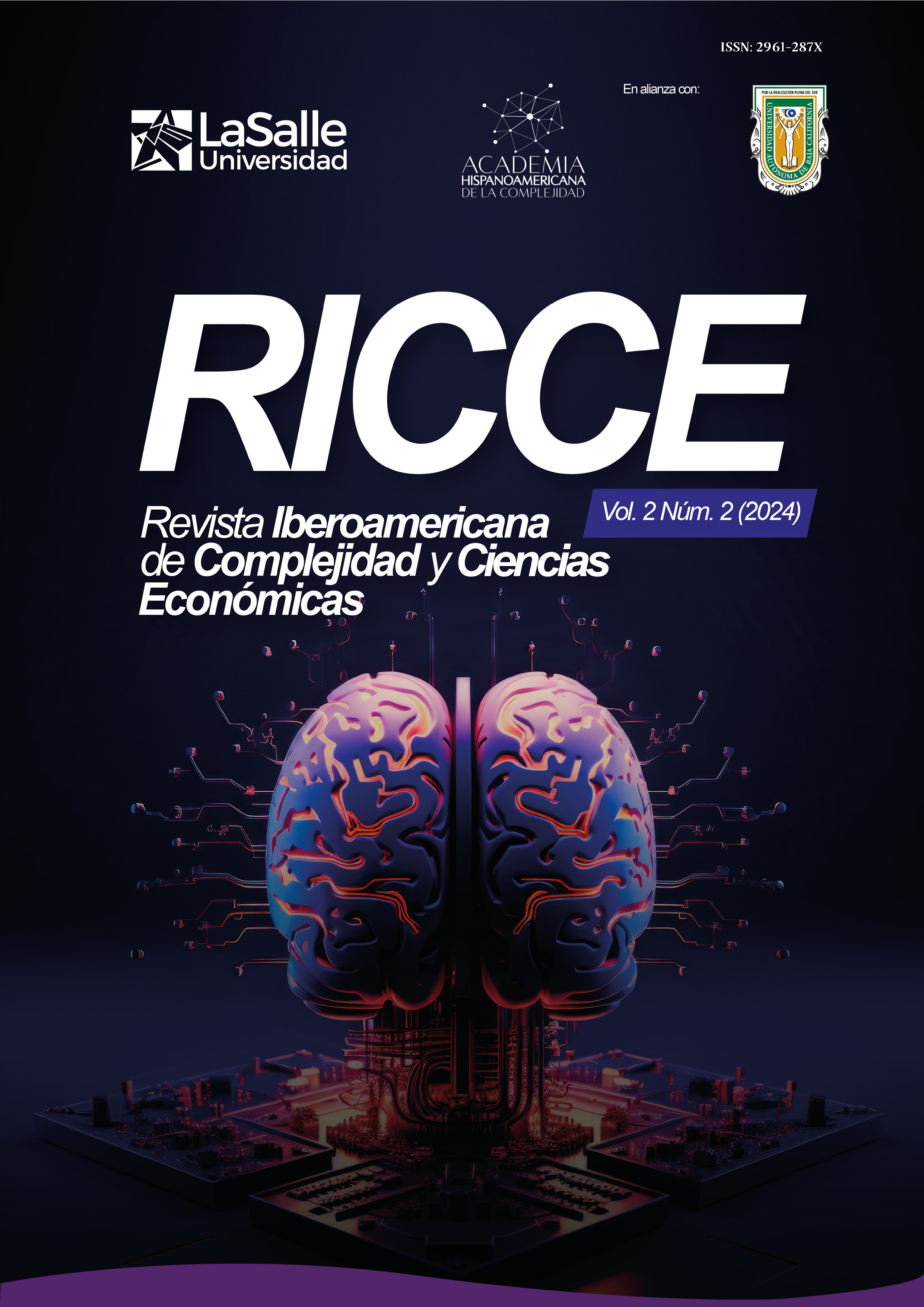COMPLEJIDAD, INTELIGENCIA ARTIFICIAL Y ÉTICA
Resumen
La relación entre la Inteligencia Artificial (IA) y las Ciencias de la Complejidad es cada vez más crucial en el ámbito científico y tecnológico. Este ensayo examina cómo la IA y las Ciencias de la Complejidad se benefician mutuamente y prometen revolucionar nuestra comprensión de sistemas complejos. Las Ciencias de la Complejidad investigan cómo las interacciones entre las partes de un sistema generan comportamientos emergentes no predecibles a partir de sus componentes individuales, abarcando redes ecológicas, economías, sistemas biológicos y sociales. La IA, con algoritmos capaces de realizar tareas que requieren inteligencia humana, como el aprendizaje y la adaptación, contribuye significativamente a este campo. Las Ciencias de la Complejidad proporcionan un marco teórico para desarrollar una IA más avanzada y adaptativa, crucial para sistemas autónomos en entornos dinámicos. Sin embargo, esta sinergia plantea desafíos éticos y sociales también novedosos, que requieren la aplicación de criterios complejos a la Ética de la Inteligencia Artificial.
Descargas
Citas
Agrawal, R., Imieliński, T., & Swami, A. (1993). “Mining association rules between sets of items in large databases”. Proceedings of the 1993 ACM SIGMOD International Conference on Management of Data, 207-216. DOI: https://doi.org/10.1145/170035.170072
Barabási, A. L. (2003). Linked: How Everything Is Connected to Everything Else and What It Means for Business, Science, and Everyday Life. Penguin.
Bar-Yam, Y. (2003). Dynamics of Complex Systems. Westview Press.
Bostrom, N. (2014). Superintelligence: Paths, Dangers, Strategies. Oxford University Press.
Brambilla, M., Ferrante, E., Birattari, M., & Dorigo, M. (2013). “Swarm robotics: a review from the swarm engineering perspective”. Swarm Intelligence, 7(1), 1-41. DOI: https://doi.org/10.1007/s11721-012-0075-2
Bryson, J. J., & Theodorou, A. (2019). “How society can maintain human-centric artificial intelligence”. In Human-Centered Digitalization and Services (pp. 305-323). Springer. DOI: https://doi.org/10.1007/978-981-13-7725-9_16
Camazine, S., Deneubourg, J. L., Franks, N. R., Sneyd, J., Theraulaz, G., & Bonabeau, E. (2003). Self-Organization in Biological Systems. Princeton University Press.
Chen, J., Li, Y., & He, K. (2018). “Reinforcement Learning in Financial Markets”. The Journal of Finance and Data Science, 4(1), 1-8. DOI: https://doi.org/10.1016/j.jfds.2015.03.001
Dorigo, M., & Stützle, T. (2004). Ant Colony Optimization. MIT Press. DOI: https://doi.org/10.7551/mitpress/1290.001.0001
Dorigo, M., Birattari, M., & Stutzle, T. (2006). “Ant Colony Optimization: Artificial Ants as a Computational Intelligence Technique”. IEEE Computational Intelligence Magazine, 1(4), 28-39. DOI: https://doi.org/10.1109/CI-M.2006.248054
Doshi-Velez, F., & Kim, B. (2017). “Towards a rigorous science of interpretable machine learning”. arXiv:1702.08608.
Floridi, L. (2019). The Logic of Information: A Theory of Philosophy as Conceptual Design. Oxford University Press. DOI: https://doi.org/10.1093/oso/9780198833635.001.0001
Floridi, L., & Cowls, J. (2019). “A unified framework of five principles for AI in society”. Harvard Data Science Review, 1(1). DOI: https://doi.org/10.1162/99608f92.8cd550d1
Goertzel, B., & Pennachin, C. (2007). Artificial General Intelligence. Springer. DOI: https://doi.org/10.1007/978-3-540-68677-4
Goodfellow, I., Bengio, Y., & Courville, A. (2016). Deep Learning. MIT Press.
Holland, J. H. (1992). Adaptation in Natural and Artificial Systems. MIT Press. DOI: https://doi.org/10.7551/mitpress/1090.001.0001
Holland, J. H. (2014). Complexity: A Very Short Introduction. Oxford University Press. DOI: https://doi.org/10.1093/actrade/9780199662548.001.0001
Kennedy, J., & Eberhart, R. (1995). “Particle swarm optimization”. Proceedings of ICNN'95 - International Conference on Neural Networks, 4, 1942-1948. DOI: https://doi.org/10.1109/ICNN.1995.488968
Kitchin, R. (2014). The Data Revolution: Big Data, Open Data, Data Infrastructures and Their Consequences. Sage. DOI: https://doi.org/10.4135/9781473909472
LeCun, Y., Bengio, Y., & Hinton, G. (2015). “Deep learning”. Nature, 521(7553), 436-444. DOI: https://doi.org/10.1038/nature14539
Mitchell, M. (2009). Complexity: A Guided Tour. Oxford University Press. DOI: https://doi.org/10.1093/oso/9780195124415.001.0001
Mittelstadt, B. D., Allo, P., Taddeo, M., Wachter, S., & Floridi, L. (2016). “The ethics of algorithms: Mapping the debate”. Big Data & Society, 3(2). DOI: https://doi.org/10.1177/2053951716679679
Newman, M. (2010). Networks: An Introduction. Oxford University Press. DOI: https://doi.org/10.1093/acprof:oso/9780199206650.003.0001
Noble, S. U. (2018). Algorithms of Oppression: How Search Engines Reinforce Racism. NYU Press. DOI: https://doi.org/10.2307/j.ctt1pwt9w5
Page, S. E. (2007). The Difference: How the Power of Diversity Creates Better Groups, Firms, Schools, and Societies. Princeton University Press. DOI: https://doi.org/10.1515/9781400830282
Provost, F., & Fawcett, T. (2013). Data Science for Business: What You Need to Know about Data Mining and Data-Analytic Thinking. O'Reilly Media.
Reichstein, M., Camps-Valls, G., Stevens, B., Jung, M., Denzler, J., Carvalhais, N., & Prabhat (2019). “Deep learning and process understanding for data-driven Earth system science”. Nature, 566(7743), 195-204. DOI: https://doi.org/10.1038/s41586-019-0912-1
Schellnhuber, H. J. (1999). “Earth system analysis and the second Copernican revolution”. Nature, 402(6761), C19-C23. DOI: https://doi.org/10.1038/35011515
Sutton, R. S., & Barto, A. G. (2018). Reinforcement Learning: An Introduction. MIT Press.
Taleb, N. N. (2012). Antifragile: Things That Gain from Disorder. Random House.
Derechos de autor 2024 Revista Iberoamericana de Complejidad y Ciencias Económicas

Esta obra está bajo licencia internacional Creative Commons Reconocimiento-NoComercial-SinObrasDerivadas 4.0.
Los autores ceden exclusivamente el derecho de publicación de su artículo a la Revista Iberoamericana de Complejidad y Ciencias Económicas, que podrá editar o modificar formalmente el texto aprobado para cumplir con las normas editoriales propias y con los estándares gramaticales universales, antes de su publicación; asimismo, nuestra revista podrá traducir los manuscritos aprobados a cuantos idiomas considere necesario y difundirlos en varios países, dándole siempre el reconocimiento público al autor o autores de la investigación.









